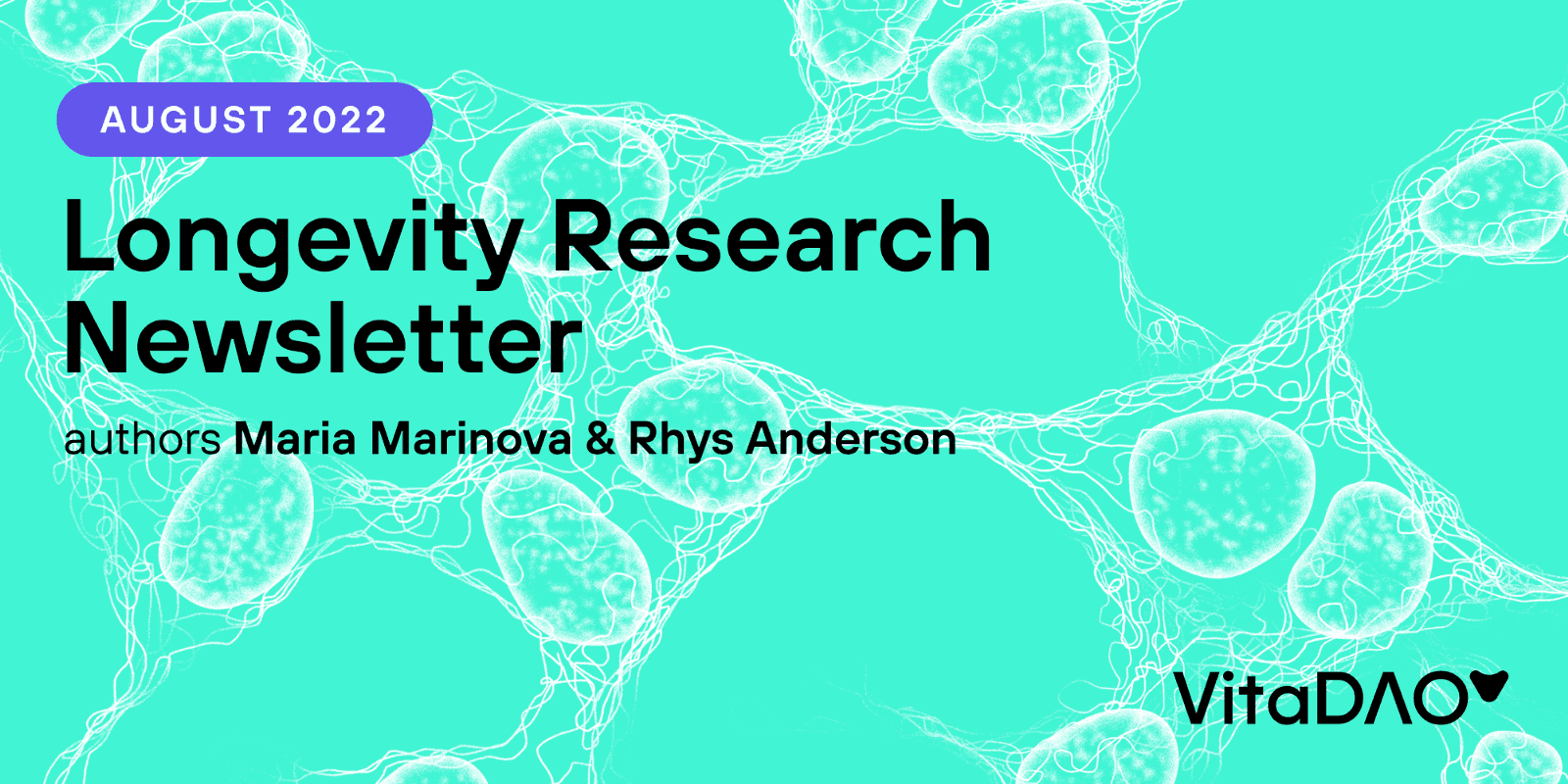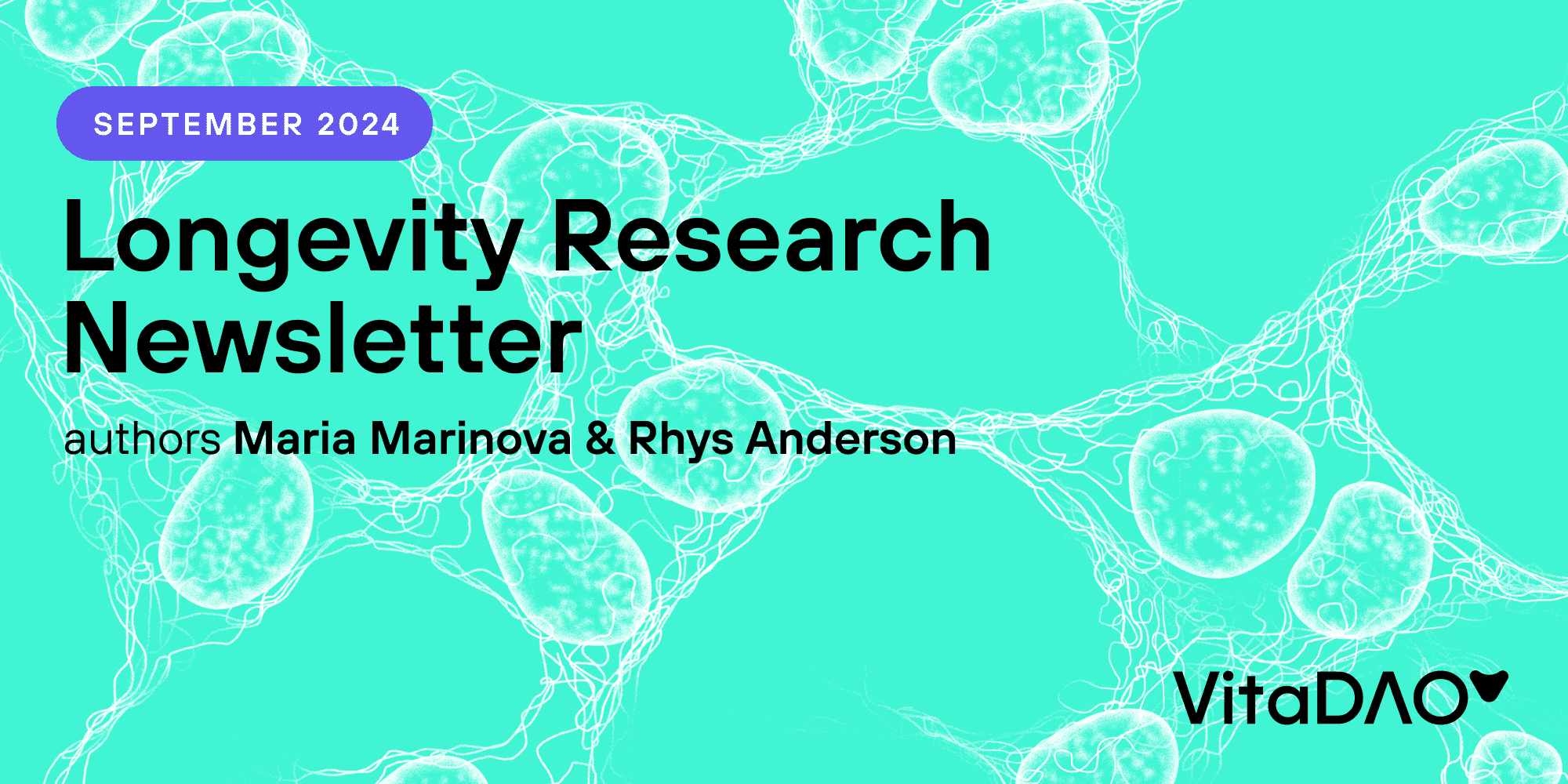
Longevity Research Newsletter August 2022


Introduction
We can all agree that the age-associated decline in physiological functionality and increased risk of developing diseases is terrible, but what can we do to treat, slow down or even prevent it?
Many people in the longevity space would agree that from the interventions explored so far, rapamycin is the one holding the most promise. This inhibitor of one of the central regulators of metabolism — mTOR — has shown positive and consistent results in extending healthy life across multiple experimental models. Research from Prof. Matt Kaeberlein’s lab showed that even transient treatment of rapamycin in middle-aged mice was enough to extend remaining lifespan by up to 60%! This would equate to around an extra 20 years of life for a 50 year-old human, however clinical trials are needed to ascertain how translatable this would be.
To highlight the importance of rapamycin, in this issue we interviewed Prof. Matt Kaeberlein and picked an interesting hot-off the press paper that focuses on the connection between development and aging, showing how even a short treatment with rapamycin in early life can also lead to a significant extension of lifespan in both flies and mice.
VitaDAO-funded Research Projects
This is the first month since starting the Longevity Newsletter that we have not funded a new project (although there are many in the pipeline) — so thought it would be a great opportunity to introduce you to the newly launched Project Pages which summarise previously funded projects and provide all the necessary links to learn more.
https://www.vitadao.com/projects/scheibye-knudsen-lab
https://www.vitadao.com/projects/turn-biotechnologies
https://www.vitadao.com/projects/rubedo-life
https://www.vitadao.com/projects/korolchuk-lab
https://www.vitadao.com/projects/evandro-fang
Longevity Literature Hot Picks
Transient rapamycin treatment during developmental stage extends lifespan in Mus musculus and Drosophila melanogaster
https://www.embopress.org/doi/full/10.15252/embr.202255299
Administration of a short rapamycin treatment during a specific time window in early life extends Drosophila lifespan, showing again the tight link between development and ageing. A potential suggested mechanism is the upregulation of sulfotransferases during early rapamycin treatment in both newborn Drosophila and mice.
Single-cell analysis of the aging female mouse hypothalamus
https://www.nature.com/articles/s43587-022-00246-4
Specific hypothalamic cell type ageing signatures were found for neuronal subtypes, microglia and astrocytes by single nuclei RNA sequencing. As expected, changes in those cell types were linked to metabolism, body composition and cognition. A surprising finding was the female specific ageing pattern driven by elevation of Xist, driver of X inactivation.
Age-dependent impact of two exercise training regimens on genomic and metabolic remodelling in skeletal muscle and liver of male mice
https://www.nature.com/articles/s41514-022-00089-8
Adult and old mice were assigned to three exercise regimens: sedentary, moderate intensity and high intensity training. The highest improvement in muscle strength, body composition and fasting blood glucose were observed in the moderate intensity aged group, while the effects for the old high intensity training were much less pronounced.
Age-associated differences in the cancer molecular landscape
https://www.cell.com/trends/cancer/fulltext/S2405-8033(22)00135-2
Certain somatic mutations occur more often in old or young cancer patients. A lot of the age-related gene expression and epigenetic changes regulate tissue microenvironment via extracellular matrix organisation, immune processes and angiogenesis with profound impact on cancer development.
A life-course approach to cardiovascular disease prevention
https://www.nature.com/articles/s41591-022-01870-8
Preventing atherosclerotic cardiovascular diseases, which is still the biggest killer in the western world, should start focusing on long-term strategies starting from an early age. New public health approaches will be needed to incentivise families with children to mitigate risk factors across the lifespan.
Is ageing a disease?
https://www.thelancet.com/journals/lanhl/article/PIIS2666-7568(22)00154-4/fulltext
An international group of clinicians have disputed the proposed revision to WHO International Classification of Disease to include the term “old age” as a diagnostic category. This term was retracted and replaced with “ageing associated decline in intrinsic capacity”.
New intranasal and injectable gene therapy for healthy life extension
https://www.pnas.org/doi/10.1073/pnas.2121499119
High-capacity cytomegalovirus (CMV) was used to deliver telomerase and follistatin both internasally or as an injectable gene therapy.This resulted in median life extension of 41.4% and 32.5% for each respective gene. Healtspan indicators such as glucose tolerance and physical performance were improved. Telomeres and mitochondrial structure were protected.
Targeting the “hallmarks of aging” to slow aging and treat age-related disease: fact or fiction?
https://www.nature.com/articles/s41380-022-01680-x
The authors highlight some weaknesses in the theory that targeting hallmarks of aging can treat age-related disease. It is difficult to make conclusions because of the overreliance on lifespan as a marker of aging, study designs that cannot clearly estimate intervention effect, and models with ambiguous relevance.
Telomeric 8-oxo-guanine drives rapid premature senescence in the absence of telomere shortening
https://www.nature.com/articles/s41594-022-00790-y
Oxidative damage did not induce premature telomere shortening as expected but it did, however, result in p-53 dependent senescence, telomere fragility and impaired replication by oxidative base lesions (8oxoG).
Systemic induction of senescence in young mice after single heterochronic blood exchange
https://www.nature.com/articles/s42255-022-00609-6
Blood from aged mice induced senescence in the young animals after a single heterochronic exchange. This effect was attenuated when the old mice were treated with a senolytic prior to blood exchange, indicating old blood rejuvenation by senescent cell clearance.
Senolytic treatment reduces cell senescence and necroptosis in Sod1 knockout mice that is associated with reduced inflammation and hepatocellular carcinoma
https://onlinelibrary.wiley.com/doi/full/10.1111/acel.13676
Sod1KO mice exhibiting accelerated aging phenotype were treated with dasatinib and quercetin (D+Q). Senescence marker p16 and numerous SASP factors ware reduced in the liver after 7 months of treatment. Expression of liver cancer and necroptosis genes was also reduced but fibrosis markers were unaffected.
A complex systems approach to aging biology
https://www.nature.com/articles/s43587-022-00252-6
The new theoretical framework is built on foundations of the principles of homeostasis, evolutionary and network theories. It proposes that organismal aging is dependent on the disruption of regulatory pathways at different hierarchical scales.
Exercise Counters the Age-Related Accumulation of Senescent Cells
Exercise attenuates multiple molecular pathways associated with aging. It can also activate an immune response in order to drive senescent cell clearance.
Histone deacetylase 4 reverses cellular senescence via DDIT4 in dermal fibroblasts
https://www.aging-us.com/article/204118/text
The role of histone deacetylase 4 (HDAC4) in cellular senescence and skin aging was investigated by RNA sequencing after OE and KD of HDAC4. DNA damage-inducible transcript 4 (DDIT4) was identified and a molecular target of HDAC4 and senescence associated factor. Its OE reversed SASP and aging-related gene expression.
Senescence: An Identity Crisis Originating from Deep Within the Nucleus
https://www.annualreviews.org/doi/10.1146/annurev-cellbio-120420-013537
Senescence is discussed as a cell identity shift and a gain-of-function phenotype, rather than loss-of-function. The cellular functionality and epigenetic features of senescent cells are defined, highlighting their heterogeneity.
The Achilles’ heel of cancer survivors: fundamentals of accelerated cellular senescence
https://www.jci.org/articles/view/158452
Cytotoxic cancer treatments induce senescence in cancer survivors and so accelerate aging and the onset of chronic disease. This review highlights senescence as a mechanism of this phenotype and provides preclinical and translational evidence of the potential of senolytics to mitigate this.
News
Longevity Foundation to Fund Geroscience Research with €860M
https://www.labiotech.eu/trends-news/geroscience-longevity-foundation/
Decentralising biotech — Molecule raises $12.7 million in seed funding
Deep Longevity Granted The First Microbiomic Aging Clock Patent
https://www.linkedin.com/pulse/deep-longevity-granted-first-microbiomic-aging-clock-patent
Insilico Medicine’s AI uncovers 28 new potential drug targets for ALS
Articles
Why longevity matters to everyone: Living longer lives in the world of Web3
The Aging Research Is On The Rise
https://www.linkedin.com/pulse/aging-research-rise-andrii-buvailo-
How sure are we that physical activity makes us live longer?
https://blogs.bmj.com/bjsm/2018/03/20/how-sure-are-we-that-physical-activity-makes-us-live-longer/
More Life — Decoding the Secret of Aging
https://m.dw.com/en/more-life-decoding-the-secret-of-aging/av-62441589?maca=en-Twitter-sharing
Aging is Still One of Biology’s Greatest Mysteries
https://www.discovermagazine.com/health/aging-is-still-one-of-biologys-greatest-mysteries
Should We Consider Aging a Disease?
https://quillette.com/2022/07/28/whats-in-a-disease/
Upcoming conferences
Ending Age-Related Diseases
August 11–14th, virtual
https://www.lifespan.io/ending-age-related-diseases-2022/
9th Aging Research and Drug Discovery (ARDD) Meeting
August 29th — September 2nd, Copenhagen
Longevity Summit Dublin 2022
September 18th-20th, Dublin
https://longevitysummitdublin.com/
7th International Cell Senescence Association (ICSA) Conference
September 29th — October 1st, Groningen
https://www.icsa2022groningen.nl/
2nd VitaDAO Crypto meets Longevity Symposium
Coming this fall (date TBC), Online
Check out our 1st symposium here: https://www.youtube.com/watch?v=GJ-rJAfjhBE
Clinical Trials
Insilico announces first patient dosed in phase I study in China of its first AI-discovered anti-fibrotic drug candidate with novel target.
https://www.eurekalert.org/news-releases/960247
Job board
Interested in pursuing a scientific career against ageing?
Check out https://rejuvenomicslab.com/ for opportunities in Prof. João Pedro de Magalãhes Lab
Research associate/Senior research associate wanted!
Dorian Therapeutics works on senoblockers to rejuvenate cells and tissues and treat age-related diseases. More about Dorian: https://www.doriantherapeutics.com/
Position application link: https://www.linkedin.com/jobs/view/research-associate-senior-research-associate-at-dorian-therapeutics-3162063900/?fbclid=IwAR3TJ0fI7fHmgBq8aOgjLRAzwHGN7TpYSkm7X0bkEFvQP1AGuDe4uRD9sPQ
Funding
Fellowship applications are open!
Scientists, engineers, and entrepreneurs in longevity, molecular machines, neurotech, computing, space, and more; we want to support you working on flourishing futures!
https://foresight.org/foresight-fellowships/
Prizes
We’re excited to bring you a new section to the newsletter this month — PRIZES!
The Longevity Prize
https://www.longevityprize.com/
VitaDAO, the Foresight Institute and the Methuselah foundation have joined forces, with the help from donors such as Vitalik Buterin to create and fund the Longevity Prize — launching with the Hypothesis Prize of $20k for person who provides the best answer for what they perceive to be the most promising but underappreciated/obscure area of longevity science that should be pursued. More prizes will also be launching soon for addressing various aspects of longevity research.
Maximon Longevity Prize
https://www.maximon.com/longevityprize
“The Maximon Longevity Prize for Translational Research awards outstanding breakthrough research in the field of longevity that can be translated for clinical or non-clinical applications and has the potential to substantially increase health span or life span of humans.”
Interview with Professor Matt Kaeberlein
Prof. Matt Kaeberlein carried out his PhD in Prof. Lenny Guarente’s lab at MIT where he began, and has continued to make, significant contributions to our understanding of the evolutionary conserved mechanisms of ageing. Currently a professor at Washington University, Prof. Kaeberlein has won numerous prizes and been elected to several gerontology/scientific societies. He also co-directs the pioneering Dog Aging Project (https://dogagingproject.org/) which works at increasing our understanding of ageing, whilst aiming to help both dogs and humans live longer, healthier lives.
What inspired you to enter longevity research?
I attended a talk by Prof. Lenny Guarente during my first year in graduate school at MIT where he discussed how his lab was using genetics, molecular biology, and biochemistry to study the biology of aging. Up to that point, I thought I would do structural biology or x-ray crystallography for my PhD, but I was so inspired by Lenny’s talk that I joined his lab and the rest is history.
How has the field changed since you started?
I’d say there have been a few big changes, mostly positive. One negative change in my view is that the field has somewhat narrowed in scope. It used to be that many people were taking unbiased approaches to identify new mechanisms and determinants of longevity. Almost nobody is doing that anymore, despite the fact that we’ve only explored a small fraction of the “intervention space” in any organism. We don’t know what we don’t know, but unfortunately very few people are looking for what we don’t know. This concerns me.
On the positive side, we now accept conserved mechanisms of aging exist and we understand a fair amount about those conserved mechanisms of aging. When I started in this field, I remember many people arguing that nothing about aging in a worm or a yeast or a fly would be shared with a mouse or a human. It is also now commonly accepted that it’s possible to intervene in aging biology during middle age, which greatly facilitates translational geroscience. It was really the Harrison et al. rapamycin study in 2009 that launched this change in perception. Before that, most people thought you would need to start early to have any significant effect in a mammal.
The field has also gained some credibility in the mainstream scientific community, larger funding sources seem to be coming online although we still lag badly in federal funding, and we are starting to see a proliferation of longevity biotech, which is fantastic.
What mistakes do you think the longevity field has made?
I think the field in general has been too slow to correct bad science in the literature. Irreproducible and overhyped studies have resulted in the waste of hundreds of millions of dollars, stained the reputation of the field, and slowed the entry of biotech and big pharma into the field.
Other than your own, what do you think have been the biggest/important discoveries in the field?
I think the Harrison et al. 2009 rapamycin study was a big one because it showed for the first time that a drug could significantly increase lifespan when treatment was started during middle age. The fact that this was an accident just makes it a better story. The discovery of senescent cells as a major in vivo contributor to age-related functional decline and disease has also obviously been hugely important and provided several opportunities for translational applications. Epigenetic and other “clocks” have had a big impact in popularization of the science and have the potential to be transformative for personalized geroscience. Reprogramming might be the breakthrough of the century — time will tell.
What advice would you give to people currently working in longevity research?
Practice healthy skepticism, of your own work and others. Be careful not to fall into the trap of confirmation bias. Always seek to identify where your model is weakest and try to break it, because that’s the only way you’ll make it better.
Which aspect of longevity research do you think requires more attention?
First, I think we need more quality clinical trials. There has been an uptick in geroscience clinical trials, which is great, but not enough well-powered and well-designed clinical trials. That’s not a knock on anyone, but a reflection of the lack of funding put towards this.
Second, I’d like to see more effort put on unbiased approaches to figure out what we’ve missed so far. In many ways the Hallmarks of Aging have been great for the field, but they have also contributed to a narrowing of scope where people have a hard time thinking outside of the hallmarks and it’s very difficult to get a grant to study anything that doesn’t fit that framework. There is a huge intervention space we have not probed in order to identify new longevity factors, which could seed future mechanistic and translational discovery.
Is ageing a disease?
That’s the wrong question. It just distracts from what’s important. Aging biology is modifiable, and we can treat it to prevent disease and maintain health.
What do you think is the biggest challenge in bringing rapamycin to the clinic to treat and prevent age-related diseases?
Money. If sufficient resources were put toward demonstrating safety and efficacy for the many indications where it seems likely rapamycin would work, the other roadblocks would fall away.
What is the most important experiment/trial you would do right now to advance the field, if there were no financial, regulatory or other restraints?
I’m not sure if it’s the most important, but one thing I would do is invest the resources to create an infrastructure that would allow for geroscience intervention testing in companion animals at the highest ethical and safety standards. We’ve created a template for how to do this with the Dog
Aging Project rapamycin trial, but it is still extremely difficult to recreate this, and nobody is really able to carry out a similar trial right now, despite the fact that there are probably 5–10 interventions that could be tested today. The benefits of showing efficacy for a geroscience intervention (or more than one) in companion animals are enormous for the field, the time frame (3–4 years) is very reasonable, and the cost is small compared to human clinical trials. It seems like a no-brainer to me.
Which other interventions do you think hold promise for improving human healthspan/lifespan?
I know it’s boring, but exercise, particularly resistance training, is the sure bet for most people to get biggest bang for the buck.
I actually think the interventions with the most promise are just sitting out there waiting to be discovered, but almost nobody is looking for them. Which is why I feel pretty excited to start exploring the intervention space at scale.
Among those we know about now, epigenetic reprogramming probably has the most upside, but in part that’s because it’s still early in development, and my intuition is that while some useful clinical applications will eventually arise, it will never achieve the effect size people are hoping for. I hope I’m wrong about that. In terms of non-lifestyle interventions, rapamycin is the safest bet right now for significant, although perhaps not huge, effect size for healthspan and lifespan benefits in people.
Outro
Thanks for your interest in the space and joining us yet again for VitaDAO’s Monthly Longevity Newsletter!
Don’t hesitate to contact us to let us know what you want to see next and give any feedback. We would love to hear from you! Until next time and if you’ve missed this month’s highlights, check them out on YouTube:
Another VitaDAO IP-NFT Transfer Ceremony with Molecule & Jonathan An
https://www.youtube.com/watch?v=JgwC2prEtSM
And a few episodes of Meet The Vitalians | Imagining the future of VitaDAO with key members of the VitaDAO community:
Laurence Ion
https://www.youtube.com/watch?v=gtmaWgnYJ8Q
Sebastian Brunemeier
https://www.youtube.com/watch?v=4JddKx2E32M
Paul Kohlhaas


